Caesalpinia pulcherrima
Caesalpinia pulcherrima is a species of flowering plant in the pea family Fabaceae, native to the tropics and subtropics of the Americas. It could be native to the West Indies,[2] but its exact origin is unknown due to widespread cultivation.[1] Common names for this species include poinciana, peacock flower, red bird of paradise, Mexican bird of paradise, dwarf poinciana, pride of Barbados, flos pavonis, and flamboyant-de-jardin. The Hawaiian name for this plant is ʻohai aliʻi.[3]
| Caesalpinia pulcherrima | |
|---|---|
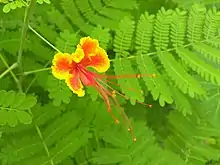 | |
| Overview of a single orange red variant flower | |
| Scientific classification | |
| Kingdom: | |
| (unranked): | |
| (unranked): | |
| (unranked): | |
| Order: | |
| Family: | |
| Genus: | |
| Species: | C. pulcherrima |
| Binomial name | |
| Caesalpinia pulcherrima | |
| Synonyms[1] | |
| |
Description
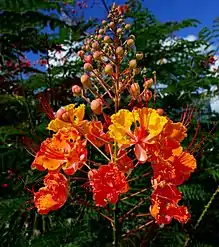
It is a shrub growing to 3 m tall. In climates with few to no frosts, this plant will grow larger and is semievergreen. In Hawaii this plant is evergreen and grows over 5 m tall. Grown in climates with light to moderate freezing, plant will die back to the ground depending on cold, but will rebound in mid- to late spring. This species is more sensitive to cold than others. The leaves are bipinnate, 20–40 cm long, bearing three to 10 pairs of pinnae, each with six to 10 pairs of leaflets 15–25 mm long and 10–15 mm broad. The flowers are borne in racemes up to 20 cm long, each flower with five yellow, orange, or red petals. The fruit is a pod 6–12 cm long.
Taxonomy
Poinciana pulcherrima is a synonym of Caesalpinia pulcherrima.[4]
Symbolism
Caesalpinia pulcherrima is the national flower of the Caribbean island of Barbados, and is depicted on the upper left and right corners of the Queen Elizabeth II's personal Barbadian flag. Claire Waight Keller included pride of Barbados to represent the country in Meghan Markle's wedding veil, which included the distinctive flora of each Commonwealth country.[5]
Uses
Food
All seeds of Caesalpinia are poisonous. However, the seeds of some species are edible before they reach maturity (e.g. immature seeds of C. pulcherrima) or after treatment (e.g. C. bonduc after roasting).[6]
Traditional medicine
Maria Sibylla Merian, a 17th-century artist, encountered this plant in the Dutch colony of Surinam.[7] In her work, Metamorphosis insectorum Surinamensium, Merian recorded that African slaves and native Indian populations used the flos pavonis or peacock flower as an abortifacient in their practice of traditional medicine.[8] She wrote:
The Indians, who are not treated well by their Dutch masters, use the seeds [of this plant] to abort their children, so that their children will not become slaves like they are. The black slaves from Guinea and Angola have demanded to be well treated, threatening to refuse to have children. They told me this themselves.[9]
The leaves, flower, bark, and seeds of C. pulcherrima were also used by American Indians in traditional medicine as abortifacients and for suicide by enslaved peoples.[7]
The extract of shade-dried flowers has been shown to arrest the cell cycle, and cause the mitochondria to commit apoptosis and necroptosis.[10]
Ornamental
C. pulcherrima is the most widely cultivated species in the genus Caesalpinia. It is a striking ornamental plant, widely grown in domestic and public gardens in warm climates with mild winters, and has a beautiful inflorescence in yellow, red, and orange. Its small size and the fact that it tolerates pruning well allows it to be planted in groups to form a hedgerow; it can be also used to attract hummingbirds.[11]
In cultivation in the UK this plant has gained the Royal Horticultural Society’s Award of Garden Merit.[12]
Gallery
 Buds opening
Buds opening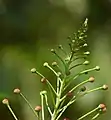 Buds
Buds Yellow flowers
Yellow flowers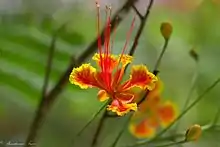 "Peacock" flower
"Peacock" flower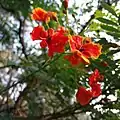 Colors in petals
Colors in petals Flowers in Jharkhand, India
Flowers in Jharkhand, India
References
- "Caesalpinia pulcherrima". Germplasm Resources Information Network (GRIN). Agricultural Research Service (ARS), United States Department of Agriculture (USDA). Retrieved 2010-12-03.
- "Tropical Flower Guide". Archived from the original on 14 October 2012. Retrieved 30 November 2012.
- "Ohai Alii – Ceasalpinia pulcherrima". Hawaii Horticulture A blog about gardening and plants in Hawaii. Retrieved 25 September 2015.
- "Poinciana pulcherrima L. — The Plant List". www.theplantlist.org.
- "The Wedding Dress: Clare Waight Keller for Givenchy". The Royal Household, UK. 19 May 2018.
- Lewis Nelson; Richard D. Shih; Michael J. Balick. Handbook of Poisonous and Injurious Plants.
- Counter, S. Allen (July 24, 2006). "Amazing mystery: A medicine man understood the secrets of this plant long before we did. How?". Boston Globe. Retrieved 22 February 2019.
- Schiebinger, Londa (2007). Plants and empire: colonial bioprospecting in the Atlantic world ([Nachdr.]. ed.). Cambridge, Massachusetts: Harvard University Press. ISBN 9780674025684.
- Edwards, Stassa. "The History of Abortifacients". Jezebel.
- Sakle, NikhilS; Lokwani, Deepak; Mokale, SantoshNamdeo (2019). "Caesalpinia pulcherrima sarrests cell cycle and triggers reactive oxygen species-induced mitochondrial-mediated apoptosis and necroptosis via modulating estrogen and estrogen receptors". Pharmacognosy Magazine. 15 (64): 288. doi:10.4103/pm.pm_100_19. ISSN 0973-1296. S2CID 201664475.
- Frisch, J.D. & Frisch, C.D., Aves Brasileiras e Plantas que as atraem, São Paulo: Dalgas Ecotec, 2005, 398, ISBN 978-85-85015-07-7
- "RHS Plantfinder - Caesalpina pulcherrima". Retrieved 12 January 2018.